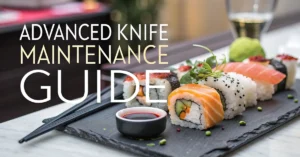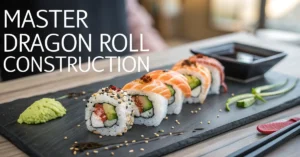Crafting sushi is an art, a delicate dance of flavors and textures. You likely know that the world of sushi is deep, with endless types and ways to enjoy this marvel. Among them, thin rolls, also called hosomaki, stand out for their simple beauty and pure taste. The allure of these seemingly simple thin rolls lies not only in their ease of eating but also in the challenge of mastering the perfect balance within a small package. Do thin rolls look like a piece of cake to prepare? Well, think twice. A thin roll might seem basic, but there is more than meets the eye, and we are here to assist you in that endeavor.
Master Hosomaki Thin Roll Technique
Hosomaki, meaning “thin roll,” are a testament to the Japanese culinary aesthetic: simplicity, elegance, and precision. These thin rolls, typically measuring about an inch in diameter, showcase the quality of a few key ingredients. For intermediate sushi makers, understanding and perfecting hosomaki technique is a great way to refine core skills and develop a deeper appreciation for the craft.
What Makes a Perfect Thin Roll?
Achieving hosomaki perfection goes beyond just rolling ingredients in rice and nori. Many elements work in harmony, and these include the rice texture, nori crispness, ingredient selection, and the neatness of the final product. When you get these parts right, you are bound to have the perfect thin rolls.
-
Rice Perfection: The foundation of any good sushi is the rice. For hosomaki, it needs to be cooked to the right moisture content. The grains should be distinct, yet cling together well enough to hold their shape.
-
Nori Quality: Crisp, high-quality nori is essential. It adds texture and a subtle ocean flavor. If the nori is not crisp enough, the final product is not going to be satisfying.
-
Ingredient Harmony: Given the simplicity of hosomaki, ingredient quality is paramount. Fresh, flavorful ingredients are best, and you want to ensure these ingredients are well-sourced.
-
Neatness and Precision: Hosomaki should be tightly rolled and neatly cut, reflecting attention to detail. Sloppy rolls are not acceptable when it comes to thin rolls.
Essential Equipment and Ingredients
Before you start, gather everything you need. Having your equipment and ingredients well-prepared contributes to a smoother and more enjoyable sushi-making experience.
- Sushi Rice: Short-grain Japanese rice is a must. Look for brands specifically labeled as “sushi rice.”
- Rice Vinegar: Seasoned rice vinegar is preferred for its balanced flavor. You can also make your own mixture of rice vinegar, sugar, and salt.
- Nori Seaweed: Full sheets of dried nori seaweed, ideally of good quality, are ideal for your thin rolls.
- Bamboo Rolling Mat (Makisu): This is essential for shaping the roll. Make sure to clean and dry it thoroughly before and after use.
- Sharp Knife: A very sharp knife is needed for clean cuts. Keep a bowl of water nearby to wet the blade and prevent sticking.
- Filling Ingredients: Common choices include tuna (tekka maki), cucumber (kappa maki), pickled radish (oshinko maki), or salmon. Pick your favorite, but do not overdo it with many ingredients.
- Water Bowl (Tezu): A small bowl of hand-dipping water, or tezu, is a mixture of water and rice vinegar to prevent the rice from sticking to your hands.
- Cutting Board: A clean cutting board to work on for cutting your sushi.
Preparing Sushi Rice: The Heart of Hosomaki
Sushi rice is more than just cooked rice. It is an art form, a balance of sweetness, acidity, and texture. It is crucial to get this step right.
- Rinsing: Rinse the sushi rice under cold water until the water runs clear. This gets rid of excess starch that can make the rice gummy.
- Cooking: Cook the rice in a rice cooker or on the stovetop. Use the rice-to-water ratio specified on the rice package. The most common ratio is 1:1.
- Seasoning: While the rice is still hot, gently mix in the seasoned rice vinegar. Use a rice paddle to avoid crushing the grains.
- Cooling: Spread the seasoned rice in a wooden or non-metallic bowl to cool. Fan the rice gently to help it cool evenly and get rid of excess moisture.
Rolling Hosomaki: A Step-by-Step Guide
Now, let’s walk through the rolling process for your thin rolls. Precision is key.
- Prepare the Nori: Place a sheet of nori on the bamboo mat, shiny side down. You can cut the nori sheet in half if you want thinner rolls.
- Apply Rice: Dip your hands in the tezu to prevent sticking. Spread a thin, even layer of sushi rice over the nori. Leave about an inch of nori uncovered at the far end.
- Add Filling: Place your chosen filling in a line across the center of the rice. Be mindful not to overfill. A single, neat row is sufficient.
- Roll: Using the bamboo mat, lift the edge of the nori closest to you over the filling. Tuck it tightly and continue to roll forward, applying gentle pressure to shape the roll.
- Seal: Once rolled, firmly press the bamboo mat around the roll to seal it. Ensure the roll is tight and uniform in shape.
- Cut: Place the roll on a cutting board. Wet your knife, then cut the roll in half. Align the halves and cut each half into equal pieces. Usually, hosomaki are cut into six pieces.
Expert Tips for Perfect Thin Rolls
Mastering hosomaki takes practice, but here are some extra tips to help you along the way:
- Rice Temperature: Work with slightly warm rice for better handling and flavor absorption.
- Nori Storage: Store nori sheets in an airtight container to maintain their crispness.
- Knife Technique: Use a gentle sawing motion when cutting to avoid crushing the roll.
- Experiment: Try different fillings to find your favorite combinations.
- Practice, practice, practice: Like any skill, the more you make hosomaki, the better you will become.
Troubleshooting Common Hosomaki Problems
Even with careful preparation, issues can arise. Here’s how to fix common mistakes:
- Rice is too Sticky: Ensure you rinsed the rice well before cooking and did not overcook it. Next time, add less water when cooking.
- Nori is Soggy: Store nori properly and make sure the rice is not too hot when rolling. If you stay in a humid place, toasting the nori might help.
- Roll Falls Apart: This usually means the roll was not tight enough. Apply more pressure when rolling and sealing.
- Uneven Cuts: Use a very sharp knife and a gentle sawing motion. Clean the blade between cuts.
Hosomaki Variations: Exploring Flavor Combinations
One of the joys of making hosomaki is the opportunity to experiment with various fillings. While traditional options are popular, don’t be afraid to get creative.
- Tekka Maki (Tuna Roll): A classic choice, featuring fresh tuna as the primary filling.
- Kappa Maki (Cucumber Roll): A refreshing and light option, perfect for a palate cleanser.
- Oshinko Maki (Pickled Radish Roll): A vibrant and tangy roll with pickled daikon radish.
- Salmon and Avocado: A creamy and rich combination that adds a touch of luxury.
- Spicy Tuna: Tuna mixed with spicy mayonnaise for those who like a bit of heat.
- Vegetarian Options: Experiment with other vegetables like carrots, bell peppers, or asparagus.
The Art of Presentation
How you present your hosomaki can elevate the dining experience. Here are some tips for beautiful plating:
- Arrange Neatly: Place the hosomaki pieces in an organized manner, often in a line or curve.
- Garnish: Add a sprig of parsley, a few sesame seeds, or a small dollop of wasabi for visual appeal.
- Dipping Sauce: Serve with soy sauce for dipping and a side of pickled ginger (gari) to cleanse the palate.
- Complementary Dishes: Accompany the hosomaki with other Japanese dishes like edamame, miso soup, or a simple seaweed salad.
Pairing Hosomaki with Drinks
The right drink can enhance the flavors of your hosomaki. Here are some suggestions:
- Sake: A classic pairing, sake complements the subtle flavors of the sushi rice and fillings.
- Green Tea: Refreshing and cleansing, green tea is an excellent choice, especially with lighter hosomaki like kappa maki.
- Japanese Beer: A crisp Japanese lager can cut through the richness of the sushi.
- White Wine: A dry white wine, such as Sauvignon Blanc or Pinot Grigio, can pair well with seafood-based hosomaki.
The History and Cultural Significance of Hosomaki
Hosomaki, while simple in form, carries a rich history and cultural significance within Japanese cuisine. Understanding its origins adds another layer of appreciation to the art of making these thin rolls. Sushi itself has evolved over centuries. Its origin lies in the ancient practice of preserving fish in fermented rice. Over time, this preservation method developed into a culinary art form. Nare-zushi, the early form of sushi, was the foundation upon which modern sushi styles were built.
As sushi evolved, different regional variations and techniques emerged. Edo-style sushi, which developed in Tokyo (formerly Edo) during the Edo period (1603-1868), became popular. This style emphasized fresh, local ingredients and more efficient preparation methods. Among the many types of sushi that arose, hosomaki gained popularity for its simplicity and focus on a single ingredient.
During the Edo period, sushi began to shift from being a preservation method to a fresh culinary dish. Street vendors and small eateries started offering quick, accessible sushi, and hosomaki became a convenient and affordable option. The simplicity of hosomaki made it ideal for busy urban lifestyles. As sushi culture spread beyond Tokyo, hosomaki’s simplicity and adaptability made it a staple in sushi restaurants across Japan and eventually around the world.
Different regions developed their own takes on hosomaki, incorporating local ingredients and flavors. For example, coastal regions might emphasize fresh seafood, while inland areas might use locally pickled vegetables. Each variation reflects the unique culinary landscape of its origin.
In modern Japanese cuisine, hosomaki holds a revered position. It is appreciated for its purity and focus on ingredient quality. Sushi chefs often use hosomaki to assess the quality of their ingredients. This is because the simple preparation allows the flavor of each component to shine through.
In sushi restaurants, hosomaki often serves as an introduction to the broader sushi menu, offering a gentle entry point for newcomers. Its light and refreshing nature also makes it a perfect palate cleanser between richer dishes. Hosomaki embodies the Japanese culinary principle of “less is more,” highlighting the beauty of simplicity and the importance of balance. The dish reflects the Japanese aesthetic of wabi-sabi, which finds beauty in imperfection and simplicity.
Today, hosomaki continues to be a beloved sushi style worldwide, appreciated for its ease of preparation, versatility, and delightful flavors. It remains a testament to the enduring appeal of simple, well-executed dishes.
Health Benefits of Thin Rolls
Hosomaki offers several nutritional benefits, making it a delicious and healthy choice. These benefits depend on the ingredients used.
- Seaweed: Nori is rich in vitamins (A, B, C, E, and K) and minerals such as iodine, iron, and calcium. It is also a good source of antioxidants and dietary fiber, contributing to overall health.
- Fish: If your thin rolls include fish such as tuna or salmon, you will also benefit from omega-3 fatty acids. These are great for heart and brain health.
- Rice: Sushi rice is a source of carbohydrates for energy, but can be high in glycemic index.
- Vegetables: Kappa maki and other vegetable-based rolls offer vitamins, minerals, and fiber.
As you can see, hosomaki has several health benefits. However, it’s important to be mindful of portion sizes and the type of fillings used. Some ingredients may have higher levels of sodium or fat.
Elevate Your Sushi Game with These Thin Rolls
Mastering the art of hosomaki is a journey of refinement and appreciation for simplicity. As you hone your technique, remember that each roll is a chance to showcase quality ingredients and your dedication to the craft. Enjoy the process, experiment with flavors, and take pride in creating these delightful, thin rolls that capture the essence of sushi in every bite.



